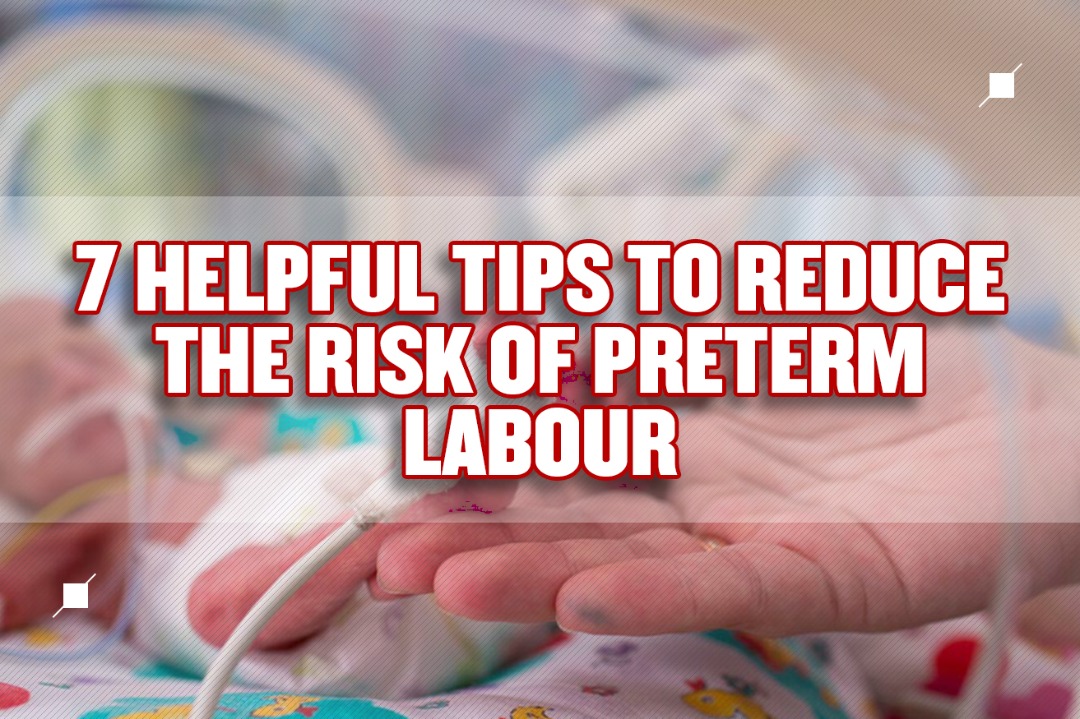Introduction
Bringing a child into the world is a joyous journey, but it comes with its share of challenges. One such concern is preterm labor, which refers to the onset of labor before the 37th week of pregnancy. Understanding the definition of preterm labor is crucial in navigating the complexities of pregnancy. It is the early initiation of the birthing process, a circumstance that poses potential risks for both the expecting mother and the newborn. In this article, we delve into the steps in reducing the risk of preterm labor, exploring proactive measures that can make a substantial difference in ensuring a healthy and full-term pregnancy.
Definition of Preterm Labor
Preterm labor, often referred to as premature labor, is when contractions of the uterus begin to open the cervix earlier than expected. This can lead to the birth of a baby before reaching full term, with potential consequences for the baby’s health and development.
Statistics and Prevalence
The statistical landscape of preterm labor adds a layer of awareness to the discussion. Globally, preterm birth complications are a leading cause of neonatal mortality, underscoring the urgency of reducing the risk.
Recent estimates from the World Health Organization (WHO) indicate that ∼12.5% of births in USA, Africa, and Southeast Asia regions are preterm; however, actual rates in Africa and Asia are expected to be much higher.
By examining prevalence rates in different demographics, healthcare providers can tailor interventions to specific populations, ensuring targeted efforts to mitigate preterm labor risks.
Understanding the Causes of Preterm Labor in Women
The journey of pregnancy, though miraculous, can be fraught with challenges, and one significant concern that expectant mothers face is the risk of preterm labor. Here are some of the causes of this risk.
Maternal Age
One of the primary factors contributing to preterm labor is maternal age. Younger mothers, especially teenagers, and older mothers, typically over the age of 35, face an increased risk. Teen pregnancies may be linked to inadequate prenatal care and socio-economic factors, while advanced maternal age may be associated with underlying health conditions. Addressing these age-related risks is crucial in reducing the overall risk of preterm labor.
Reducing the risk of preterm labor associated with maternal age involves tailored interventions. Younger mothers may benefit from increased educational resources, while older mothers may require closer monitoring and proactive health management.
Multiple Pregnancies
Carrying more than one baby, such as twins or triplets, significantly elevates the risk of preterm labor. The increased strain on the uterus and cervix can trigger early contractions. Managing the unique challenges of multiple pregnancies is vital in reducing the risk of preterm labor and ensuring the well-being of both the mother and each baby.
Reducing the risk of preterm labor in multiple pregnancies involves specialized care plans. Regular monitoring, lifestyle adjustments, and potential medical interventions may be employed to enhance the chances of a full-term pregnancy.
Underlying Health Conditions
Various underlying health conditions, such as hypertension, diabetes, and infections, can heighten the risk of preterm labor. These conditions may compromise the stability of the uterine environment, necessitating vigilant management. Addressing and controlling these health issues are integral components of reducing the overall risk of preterm labor in women with such conditions.
Reducing the risk of preterm labor associated with health conditions requires a comprehensive approach. This involves close collaboration between healthcare providers and expectant mothers to manage and mitigate potential complications.
Lifestyle Factors
Certain lifestyle choices can contribute to an increased risk of preterm labor. Smoking, substance abuse, and inadequate nutrition are notable factors that demand attention. Educating and supporting expectant mothers in making healthier lifestyle choices play a crucial role in reducing the risk of preterm labor associated with these factors.
Reducing the risk of preterm labor tied to lifestyle factors involves comprehensive support. Smoking cessation programs, substance abuse counseling, and nutritional guidance are essential components of a holistic approach.
Previous Preterm Births
Women who have previously experienced preterm labor are at a higher risk of recurrence. Understanding and addressing the factors that led to the previous preterm birth are paramount in reducing the risk in subsequent pregnancies. Specialized care plans and vigilant monitoring can significantly contribute to a successful full-term pregnancy.
Reducing the risk of preterm labor in women with a history of preterm birth involves proactive measures. Close collaboration between the expectant mother and healthcare providers ensures a tailored approach to address specific risk factors.
The Importance of Prenatal Care: Ensuring a Healthy Pregnancy Journey
Embarking on the beautiful journey of pregnancy involves a series of essential steps, and none is more critical than prenatal care. Recognizing the significance of prenatal care goes beyond the routine; it’s about actively engaging in strategies that reduce the risk of preterm labor, ensuring a healthy and full-term pregnancy for both the expecting mother and the precious life she carries.
Regular Check-ups
Reducing the risk of preterm labor begins with regular check-ups. These appointments allow healthcare providers to detect and address potential issues early, offering timely interventions that can significantly impact the trajectory of the pregnancy.
Monitoring and Early Detection
Monitoring and early detection form a dynamic duo in the quest to reduce the risk of preterm labor. Advanced monitoring techniques, such as ultrasounds and other diagnostic tests, provide valuable insights into the intricate aspects of pregnancy. By leveraging advanced technologies and vigilant observation, healthcare providers can address emerging issues swiftly, promoting a healthier gestation period.
Empowering Expectant Mothers
Empowering expectant mothers through prenatal care is fundamental to reducing the risk of preterm labor. Informed and supported mothers are better equipped to make choices that contribute to a healthy and full-term pregnancy.
Healthy Lifestyle Choices
Nurturing a resilient pregnancy involves not only understanding the importance of these choices but actively implementing strategies that reduce the risk of preterm labor, ensuring optimal well-being for both the mother and the developing baby.
Nutrition
Nutrition plays a pivotal role in fostering a healthy pregnancy. Reducing the risk of preterm labor begins with nutrition. A well-balanced diet, rich in key nutrients, supports the intricate process of fetal development and minimizes potential factors that could contribute to preterm labor.
Supplements like Evergreen Natal Care helps to supply both the mother and her unborn child the necessary nutrients needed.
Exercise
Engaging in regular, moderate exercise enhances overall well-being, promotes healthy weight management, and contributes to a reduced risk of preterm labor. Tailored exercises, such as prenatal yoga or swimming, can alleviate stress and enhance the body’s resilience. By incorporating safe and enjoyable physical activities, expectant mothers actively embrace a lifestyle choice that is pivotal in reducing the risk of preterm labor.
Cultivating physical well-being through exercise is a proactive step in reducing the risk of preterm labor. Safe and enjoyable activities contribute to a healthier pregnancy, both physically and mentally.
Stress Management: Nurturing a Calm Pregnancy Journey
By prioritizing stress management, expectant mothers can significantly contribute to reducing the risk of preterm labor, ensuring a serene environment for a healthy pregnancy.
Techniques for Stress Reduction
Some techniques to reduce the risk of preterm labor are:
- deep breathing,
- meditation, and
- gentle exercise
Avoiding Substance Abuse Risks
Understanding these risks is paramount in the effort to reduce the risk of preterm labor. Substance abuse, whether it involves illicit drugs or the misuse of prescription medications, can lead to complications such as preterm birth, low birth weight, and developmental issues.
Smoking Cessation and Alcohol Moderation
Two prevalent harmful substances during pregnancy are tobacco and alcohol. Smoking cessation and alcohol moderation are proactive lifestyle choices that can drastically reduce the risk of preterm labor risk.
Smoking exposes both the mother and the baby to harmful chemicals that can contribute to preterm birth and low birth weight. Similarly, excessive alcohol consumption is associated with an increased risk of preterm labor and developmental issues. Choosing to quit smoking and moderating alcohol intake actively contribute to a healthier pregnancy and a substantial reduction in the risk of preterm labor.
Adequate Sleep
During pregnancy, the importance of adequate sleep transcends mere rest; it plays a vital role in reducing the risk of preterm labor. Understanding sleep’s role in this context and actively implementing tips for better sleep during pregnancy become integral components of fostering a healthy and full-term gestation.
Sleep’s Role in Reducing Preterm Labor: Unveiling the Connection
- Quality sleep contributes to the overall well-being of expectant mothers,
- Helps in hormonal balance
- immune function.
- Adequate rest is linked to a lower risk of complications such as preeclampsia and gestational diabetes, both of which can contribute to preterm labor.
Reducing the risk of preterm labor starts with acknowledging sleep’s crucial role. Quality sleep is not just a luxury; it is a fundamental component in promoting a healthy pregnancy journey.
Tips for Better Sleep During Pregnancy
- Create a Comfortable Sleep Environment
- Establish a Relaxing Bedtime Routine
- Monitor Fluid Intake Before Bed
- Maintain a Consistent Sleep Schedule
- Invest in Maternity Pillows
- Limit Screen Time Before Bed
- Listen to Soothing Music or White Noise
- Use Supportive Sleep Positions
Water Intake Benefits: Nourishing the Pregnancy Journey
Reducing the risk of preterm labor begins with recognizing the vital role of hydration. Adequate water intake is not just a routine; it is a fundamental aspect of nourishing the intricate journey of pregnancy.
Practical Tips for Optimal Hydration During Pregnancy: A Guide
- Carry a Water Bottle: Keep a water bottle handy throughout the day to encourage regular sips and maintain hydration levels.
- Set Hydration Goals: Aim for a specific daily water intake goal. This can be personalized based on individual needs, climate, and activity levels.
- Infuse Water with Natural Flavors: Add slices of fruits or herbs to water for a refreshing twist. This can make hydration more enjoyable and appealing.
- Monitor Urine Color: Pay attention to urine color; light yellow indicates proper hydration, while dark yellow may signal dehydration.
- Include Hydrating Foods: Incorporate foods with high water content, such as fruits and vegetables, into meals and snacks.
- Establish a Hydration Routine: Integrate hydration into daily routines, such as drinking a glass of water upon waking up and before going to bed.
- Limit Caffeine and Sugary Beverages: While some caffeine is generally considered safe during pregnancy, excessive amounts can contribute to dehydration. Opt for water as the primary beverage.
- Listen to Thirst Signals: Respond to the body’s signals for thirst promptly. Waiting until feeling thirsty might indicate dehydration has already started.
- Adjust Hydration Based on Activity Levels: Increase water intake during hot weather or after physical activity to compensate for additional fluid loss.
Monitoring High-Risk Indicators
Recognizing warning signs and promptly seeking medical attention form an integral strategy in reducing the risk of preterm labor, ensuring optimal well-being for both expectant mothers and their developing babies.
Recognizing Warning Signs
- Vaginal Bleeding
- Severe Abdominal Pain
- Fluid Leakage
- Decreased Fetal Movement
- High Blood Pressure: Elevated blood pressure, especially when accompanied by symptoms like headache and vision changes, requires prompt attention.
- Preterm Labor Symptoms
- Signs of Infection: Symptoms such as fever, chills, and unusual vaginal discharge may indicate an infection.
Prompt Medical Attention
Reducing the risk of preterm labor hinges on the promptness of medical attention. Expectant mothers are encouraged to prioritize their well-being and promptly report any warning signs to their healthcare providers.
Building a Support System
Involving friends and family and seeking mental health support become integral components in reducing the risk of preterm labor, ensuring optimal well-being for both expectant mothers and their developing babies.
Practical Tips for Building a Support System
- Communicate Openly
- Delegate Responsibilities
- Join Prenatal Classes: Participate in prenatal classes or support groups to connect with other expectant parents, fostering a sense of community.
- Prioritize Self-Care
- Educate Support System: Share information about pregnancy milestones, potential challenges, and ways friends and family can provide support.
- Consider Professional Counseling
- Establish Boundaries: Clearly communicate boundaries with friends and family to ensure a balance between support and personal space.
Building a support system involves practical steps that actively contribute to reducing the risk of preterm labor. These tips guide expectant mothers in creating a network that nurtures emotional well-being and promotes a positive pregnancy journey.
Conclusion
Nurturing a healthy and full-term pregnancy involves a multifaceted approach. From prioritizing adequate sleep, maintaining optimal hydration, and making healthy lifestyle choices to building a robust support system and vigilantly monitoring high-risk indicators, expectant mothers play a pivotal role in reducing the risk of preterm labor.
By recognizing warning signs promptly, seeking medical attention when needed, and actively engaging in lifestyle choices that promote well-being, the journey towards motherhood becomes a path marked by awareness, resilience, and the assurance of a reduced risk of preterm labor. Embracing these strategies ensures an environment where the joy of pregnancy is accompanied by a commitment to a full-term, thriving newborn.
Frequently Asked Questions
Can preterm labor be completely avoided?
While complete avoidance is not always possible, proactive measures significantly reduce the risk.
How does stress contribute to preterm labor?
Stress triggers hormonal changes that can impact the uterine environment, potentially leading to preterm labor.
What role does the partner play in reducing preterm labor risk?
A supportive partner can help alleviate stress, encourage healthy habits, and share responsibilities.
Are there specific foods that can help prevent preterm labor?
Certain nutrient-rich foods contribute to a healthy pregnancy; we explore dietary choices in the article.

















